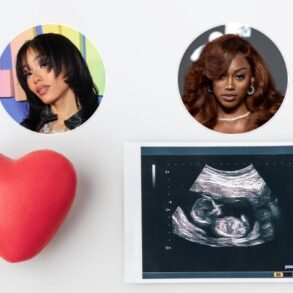8 female voices that have helped shaped hip hop culture
Hip hop is celebrating a massive milestone this year – 50 years in the game, and it’s never looked or sounded so good.
Arguably, hip hop in its present state is enjoying an apex of creative progression that feels rejuvenated, and fresh. Emerging voices across genre subcultures are less defined by the sounds of those who came before them.
This isn’t to say that the foundational voices of hip hop are fading into the background – it’s their art and presence that has made it possible for your current faves to flourish in their individuality.
Throughout the years, we’ve seen the multi-generational impact everyone from Dr. Dre and Snoop Dogg, through to Jay-Z and Bun B have had. But when it comes to the many female MCs who are key to hip hop’s early DNA, and still ensuring its legacy today, this 50th anniversary year is the perfect time to give these ladies their flowers.
We know of icons — Salt ‘n’ Pepa, Missy Elliott, Queen Latifah, Lil Kim, Ms. Lauryn Hill but what about the Philly MC who was at the helm of the first ever hip hop LP to be entirely written and co-produced by a female? Or how about the first Platinum-selling female rapper?
Below are just a selection of female MCs key to any hip hop education.
Da Brat
Hailing from Chicago, Da Brat made her first steps into the spotlight after winning a local rap contest, which eventually led to her being introduced to the legendary producer Jermaine Dupri of So So Def.
Two years after signing with So So Def, Da Brat released her debut album Funkdafied – a fusion of hip hop and G-Funk that featured iconic tracks including ‘Funkdafied’ and ‘Give It 2 You’. Selling over one million copies, the album became certified platinum, making Da Brat the first solo female rapper to achieve the feat.
Loading
The release of Funkdafied and its impact on the culture at this time is important to note when we consider the landscape of the time. Released in 1994, the album came through in the same year as some culture defining records. We’re talking Nas’ Illmatic, The Notorious B.I.G.’s Ready To Die, Beastie Boys’ Ill Communication, Outkast’s Southernplayalisticadillacmuzik.
For a female-led project such as Funkdafied to land in the way it did was remarkable, and positioned Da Brat early as a cultural figure that couldn’t be denied her props.
Roxanne Shante
An undeniable pioneer of hip hop, period, is Roxanne Shante.
Born and raised in Queens, New York City, Shante first rose to notoriety as a 14 year old, when she appeared on ‘Roxanne’s Revenge’, a Marley Marl-produced rebuttal track that directly called out Brooklyn rap crew UTFO. It was one of the first recorded cases of beef between artists.
Rapping since she was a child, Shante caught the attention of the Juice Crew, the collective that also was home to the likes of Big Daddy Kane, Biz Markie and more.
Loading
The release and success of ‘Roxanne’s Revenge’ was largely down to Shante’s visceral presence on the track; for a teenage girl, the way she confidently wrapped herself around her bars spoke to a level of self-assuredness normally belonging to someone much older and experienced.
Often regarded as one of the best diss tracks in general, ‘Roxanne’s Revenge’ set a standard within the genre that we’d see be built upon.
With only two albums to her name – 1989’s Bad Sister and 1992’s The Bitch Is Back – Roxanne Shante’s star rose quickly within the culture. But by the age of 25, she was all but retired from the industry, and for many decades, her influence and impact was largely overlooked.
Recent years have seen Shante’s impact revisited, rightly so, recognising that even though her career was a short one, she was one of the best and fiercest voices to get behind a mic.
The Lady Of Rage
Even if you don’t know her by name, chances are, if you’re a classic hip hop fan, you’ve heard The Lady of Rage‘s voice. Virginia born, Los Angeles based, she’s intrinsically tied to the development of West Coast hip hop.
Discovered by Dr. Dre after he heard her work with the L.A. Posse in 1991, the Lady of Rage was brought into the Death Row Records family, appearing across several tracks on two of the most important records the genre has seen: Dr. Dre’s The Chronic and Snoop Dogg’s Doggystyle.
Her strength on record made the Lady of Rage an instant drawcard: masterful lyrical flow and a boldness when it came to leaning into the more hardcore areas of hip hop, she emerged very quickly in the ’90s as a dominant force.
Continuing to collaborate with Death Row artists throughout the decade, the Lady of Rage stepped into her own spotlight with the release of her debut album (and her only studio record to date), Necessary Roughness, in 1997.
Loading
Featuring collaborations with 2Pac, Daz Dillinger and Snoop, with production by icons like DJ Premier and Dillinger, the album represented a great intersection of hardcore hip hop and the gangsta rap Death Row had made famous during a notably chaotic period in the genre’s history.
Since 1998, the Lady of Rage has enjoyed success as an actor, but has continued to appear on numerous projects into the 2010s, linking up with artists such as Warren G, MC Lyte and frequent collaborator, Snoop Dogg.
Trina
The Diamond Princess or Da Baddest Bitch, whatever name you know her by, the impact Trina has had on hip hop as the genre moved into the 2000s is undeniable.
The Miami rapper, best known for her work with artists like Trick Daddy, Missy Elliott and Ludacris, established herself as a worthy name to follow the likes of Lil Kim and Foxy Brown when it came to bold and nasty bars, with the release of Da Baddest Bitch in 2000.
Loading
The record paired production unique to that Miami bass sound, with a sexual liberation and confidence that was jarring at the time, coming from the 21 year old Trina. The legacy of this album in particular, followed closely by 2002’s Diamond Princess, set a blueprint for a whole wave of contemporaries that have redefined female rap in the 2010s and 2020s.
Without a Trina, there’d be no City Girls, Latto or Flo Milli. Cornering an area in the market for the rap divas, Trina continues to be one of hip hop’s most consistent female figures.
Bahamadia
Antonia D. Reed, aka Bahamadia, is an influential name that a lot of new-school hip hop heads may not be too familiar with.
The Philadelphia artist made her first entry to the scene with the release of her debut album in 1996, the seminal Kollage. Coming out during what many would consider to be hip hop’s golden era, the raw expression of ideas and sonic influences set Bahamadia aside from the flashiness of other releases at the time.
Co-producing the album, and writing the record herself, Bahamadia was one of the first female rappers to deliver one of the best debut records of the 1990s, while remaining the key driving force behind it.
Loading
Incorporating a diverse palette of influences, from Aretha Franklin to A Tribe Called Quest, Bahamadia rode in a lane that was taking her in another direction than that of the era’s leading labels, Bad Boy and Death Row. She emerged as a poetic and socially switched-on rapper, and found herself working with the likes of The Roots, DJ Premier and Gang Starr.
If you’re a fan of artists like Rapsody, Noname or Jamila Woods, the musical DNA of Bahamadia is likely woven right throughout their music.
Eve
Ruff Ryders’ First Lady, Eve is one of the best female emcees there is; respected for her lyrical capabilities and punch on any record she touched. Not many could have stood toe to toe with such a force like DMX.
Another Philly native, Eve released her debut album under Ruff Ryders Entertainment in 1999, fittingly titled Let There Be Eve…Ruff Ryders’ First Lady. The record, now certified double Platinum, made Eve the third ever female hip hop artist to snag the #1 spot on the Billboard 200, following on from Lauryn Hill and Foxy Brown.
Interestingly, though Eve is widely known for her association with Ruff Ryders, her first actual appearance was under another hip hop icon: Dr. Dre. Then known as Eve of Destruction, Eve’s career began as part of Aftermath Records.
Loading
It’s Eve’s triumphant run through the 2000s that puts her on this list; her work as a solo artist and collaborator with many big names outside of rap stand out as great examples of hip hop’s steps into crossover, mainstream success. The release of her second album, Scorpion in 2001, made Eve a global name, solidified by the success of singles like ‘Who’s That Girl?’ and the Grammy winning, Gwen Stefani-featuring smash, ‘Let Me Blow Ya Mind’.
Further collabs with Alicia Keys, Sean Paul, Ludacris, Kelly Rowland and more highlighted Eve’s versatility as a rapper, as well as her work ethic; while her music career continued to flourish, she was also moving into film and TV projects.
Culturally, Eve’s impact will always be respected; she is one of the greatest success stories to come out of Ruff Ryders, second only to DMX himself.
Yo-Yo
Yo-Yo remains an architect of change and mentorship within hip hop today. One of the most recognisable female voices to come out of the West Coast hip hop scene in the 1990s, Yo-Yo was mentored herself by Ice Cube, who gave her her first appearance, on AmeriKKKa’s Most Wanted (on ‘It’s A Man’s World’).
Releasing her debut album Make Way For The Motherlode in 1991, Yo-Yo matched abrasive delivery with insightful and positive lyrical matter. A fusion of grit and soul, highlighting her femininity, as well as her staunch stance on not sacrificing it for anyone, Yo-Yo’s debut positioned her somewhere between Queen Latifah and MC Lyte.
Loading
1992’s Black Pearl furthered Yo-Yo’s growing position as a feminist rapper, with the record’s themes choosing to focus on uplifting and positive messages, as opposed to the hardcore and gangsta rap that was dominating the West Coast at the time. Even dubbing her crew the “IBWC” – the Intelligent Black Woman’s Coalition – Yo-Yo has been a longtime advocate for women, and more specifically, the breaking down of hip hop’s long history of misogyny and sexism.
Yo-Yo’s work as a mentor and guiding figure for younger artists has continued into today; she founded the Yo-You School of Hip-Hop specifically to help at-risk youth and students via hip hop used in curriculum.
Sha-Rock
Known as the ‘Mother of the Mic’, Sharon ‘Sha-Rock’ Green is considered to be the first female rapper. A clear influence on artists like MC Lyte and even DMC of Run-D.M.C., she is the epitome of a trailblazer.
Growing up in the South Bronx, Sha-Rock was at the centre of hip-hop’s evolution during its infancy. She is noted as being the first female hip hop emcee to be recorded on vinyl, and the first to release records commercially. As a member of the Funky 4 + 1 crew (she being the “+1”), Sha-Rock also became the first female MC to appear on television, when the “street rappers” appeared alongside Blondie on Saturday Night Live in 1981.
Her image wasn’t sexualised by her male counterparts or by the public, rather Sha-Rock was uplifted and regarded as an equal – making her an early inspiration for females who would make their way into hip hop in the second half of the 1980s.
Loading
Check out more highlights from the past 50 years of hip hop right here.
This post was originally published on this site be sure to check out more of their content.





